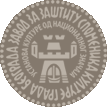|
| |
| |

БИФОРА ТРПЕЗАРИЈЕ
|
| |

ЧАСНА ТРПЕЗА ИЗ ЦРКВЕ
|
| |

ЦРКВА
|
| |

КОНАК
|
| |

ТРПЕЗАРИЈА, ДЕТАЉ
|
| |

МАНАСТИРСКИ КОМПЛЕКС, СИТУАЦИЈА
|
| |
 |
| |
|
|
|
|

ОПШТИ ИЗГЛЕД МАНАСТИРСКОГ КОМПЛЕКСА
|
|
| |
| |
Cultural monument
Kastaljan Monastery,
Nemenikuće
Споменик културе
Манастир Кастаљан,
Неменикуће |
|
|
|
|
|
| The monastery complex of Kastaljan lies on the eastern, woody slope of Kosmaj, to the village of Nemenikuće. The complex comprises a church, living quarters and refectory. Several systematic archeological diggings were performed here and the results of the architectural and stylistic analyses of the found objects and the movable archeological material indicate three phases of building and exploitation of the space. The church presumably built in the fourteenth century belongs to the first and oldest phase. In the second phase the church underwent certain alterations and a refectory was added then. It is the beginning of the fifteenth century and the rapid ascent of the new despotic Serbia. The newly built refectory with the church turned to a chapel served as despot Stefan’s summer residence. The third phase of building and the final shaping of the space into a monastery complex is connected to the building of the living quarters. Considering the confirmed archeological and historic facts and the exceptional architectural value of the preserved remains of the monastery complex, with the sediments of architectural procedures applied within a relatively long period from the fourteenth to the end of the seventeenth centuries, when the monastery was demolished, the complex on the site of Kasteljan represents a cultural heritage of exceptional worth for the study of the period when the Serbian ruler was despot Stefan Lazarević, and particularly for the area of Kosmaj which was the religious centre at that time. |
| |
 |
| |
 |
| |
|
|
|
| |
| Манастирски комплекс Кастаљан смештен је на источној, шумом покривеној падини Космаја према насељу Неменикуће. Комплекс се састоји од цркве, конака и трпезарије. На основу резултата систематских археолошких ископавања, архитектонске и стилске анализе откривених објеката и покретног археолошког материјала, могу се издвојити три фазе градње и коришћења простора.
Првој и најстаријој фази припада црква чија се градња може сместити у XIV век. У другој фази црква је претрпела извесне измене, а тада је подигнута и трпезарија. То је време почетка XV века, наглог успона тек створене деспотовине Србије. Новоизграђени објекат са преправљеном црквом у функцији капеле, служио је деспоту Стефану као летњи двор. Трећу фазу градње и коначно уобличавање простора у манастирски комплекс представља подизање конака.
С обзиром на утврђене значајне археолошке и историјске чињенице, као и на изразиту архитектонску вредност очуваних остатака манастирског комплекса, са наталоженим градитељским поступцима примењиваним у сразмерно дугом временском периоду од XIV до краја XVII века, када је манастир разорен, комплекс на локалитету. Кастаљан представља споменик изузетних вредности за проучавање и сазнања о времену Србије деспота Стефана Лазаревића, а нарочито за област Космаја која је у то време имала улогу великог верског центра. |
| |
Службени лист града Београда бр. 16/87 |
|
|
| |
|
|
| |
|
|
|
|
|